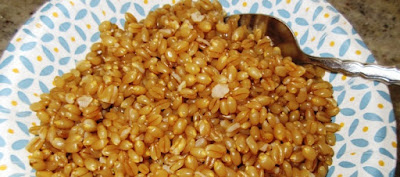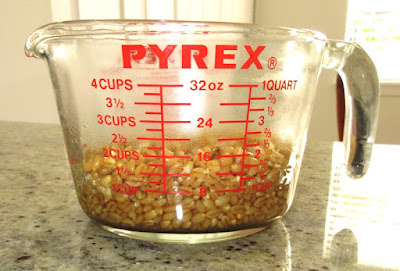Recipe of the week at SurvivalBlog.com along with some tips:
https://survivalblog.com/recipe-week-pennys-quick-cooked-wheat-berries/
Recipe of the Week: Penny’s Quick-Cooked Wheat Berries
JAMES WESLEY RAWLES JUNE 10, 2019
We are always looking for recipes for storage foods. This one is particularly useful.
Reader Penny in Arkansas kindly sent us her directions for cooking wheat berries.
There are far more uses for your stored wheat than just grinding flour! Infogalactic has this description:
“A wheat berry, or wheatberry, is a whole
wheat kernel (except for the
hull/husk), composed of the
bran,
germ, and
endosperm. Botanically, it is a type of fruit called a
caryopsis. Wheat berries have a tan to reddish-brown color and are available as either a hard or soft processed grain. They are often added to
salads or baked into
bread to add a crunchy texture. If wheat berries are
milled,
whole-wheat flour is produced.
Wheat berries are the primary ingredient in an
Eastern European Christmas
porridge called
kutya. In France, cooked durum wheat berries are commonly eaten as a side dish instead of rice or corn. This side dish is often called
ebly, from the name of the first brand of prepared wheat berries.”
You can of course soak whole wheat kernels overnight with no heat, to swell and soften wheat berries, and then quickly heat them for serving, with nutritive value. But there is also Penny’s “quick-cooked” method:
INGREDIENTS
- Any desired quantity of wheat that will fit in a cooking pot, but leaving room for double that volume of water.
- Water (tap water or treated rainwater)
- Salt, to taste, and to match your doctor’s orders.
DIRECTIONS
- Carefully examine the wheat, to make sure that there is no chaff (hulls), dirt, pebbles, or grit. Failure to do so could mean a trip to the dentist!
- Place the cleaned wheat kernels in a soup pot.
- Add at least twice the volume of water to the volume of wheat.
- Put your stove top on a high flame and bring the pot to a full boil.
- Reduce burner heat to low.
- Cover pot with a lid.
- Simmer the wheat berries for 1 hour, stirring occasionally.
- After one hour, the wheat berries should be soft enough to eat.
- Drain and briefly rinse the wheat berries. (Do not rinse them too long, or they will lose too much heat.)
SERVING
- To serve the wheat berries hot, serve them immediately after cooking.
- To serve after refrigeration, the wheat berries can be re-heated in a microwave oven or quickly re-heated in a saucepan on your stovetop. Do not overcook them!
- Wheat berries can be served just like cooked oats, as a breakfast cereal. Cover with milk, cream or yogurt, and add fruit and a dash of maple syrup, honey, or brown sugar. Yummy!
STORAGE (AFTER COOKING)
Cooked wheat berries can be stored in your refrigerator to parcel out in servings for up to 48 hours. After that, for safety they should be either fed to your chickens, or composted.
Cooked wheat berries can be stored in your freezer for up to 30 days.
A USEFUL LINK
Cooking With Wheat: 5 Ways to Use Those Wheat Berries
https://www.offthegridnews.com/food/cooking-with-wheat-5-ways-to-use-those-wheat-berries/

